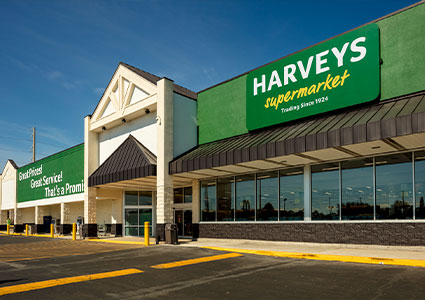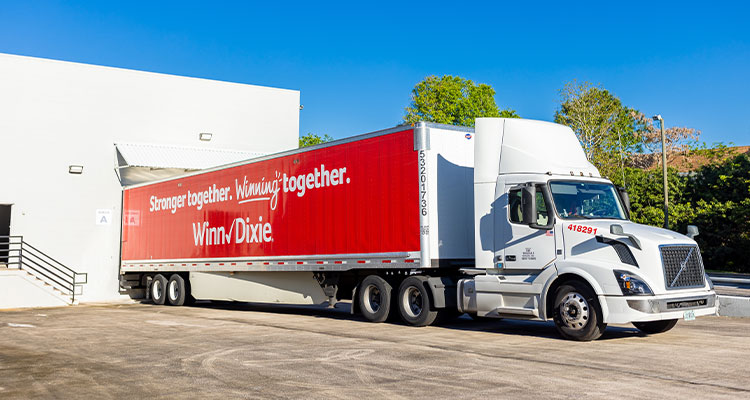Community values and collaborative leadership shape Southeastern Grocers’ supply chain
Headquartered in Jacksonville, Florida, Southeastern Grocers (SEG) is the parent company of Harveys Supermarket and Winn-Dixie grocery stores. SEG is an omnichannel retailer, serving customers in its brick-and-mortar grocery and liquor stores, as well as offering delivery and curbside pickup in Alabama, Florida, Georgia, Louisiana, and Mississippi.
Harveys Supermarket has a deep heritage and strong neighborhood connections since 1924. Similarly, Winn-Dixie was founded in 1925, serving five states with a proud commitment to providing the best quality, value, and service for customers.
 From a supply chain perspective, Paul McDaniel, Vice President of Supply Chain Operations, and his team work to ensure seamless supply across SEG’s network. With an extensive career spanning supply chain management, Paul is well equipped to build resiliency and enhance agility in his current role.
From a supply chain perspective, Paul McDaniel, Vice President of Supply Chain Operations, and his team work to ensure seamless supply across SEG’s network. With an extensive career spanning supply chain management, Paul is well equipped to build resiliency and enhance agility in his current role.
“I earned my undergraduate degree in supply chain management before the term was widely recognized,” Paul begins. “At the time, Arizona State University referred to the program as ‘Purchasing and Logistics Management.’ My foundational career began at General Mills, where I gained invaluable experience in both manufacturing plants and corporate headquarters.
“During the General Mills acquisition of Pillsbury, I relocated to Bentonville to collaborate with Walmart on supply chain initiatives that drove significant growth for both companies. This role deepened my understanding of the retail supply chain’s transformative potential, leading me to pursue an MBA at the University of Arkansas. Transitioning from manufacturing to retail was pivotal in my career, and it prepared me for the rewarding challenges I now face within retail.”
Effective leadership is key
Turning to his current role, Paul continues: “I lead the Supply Chain Operations team at SEG, overseeing the end-to-end value chain from supplier to shelf. I’m fortunate to collaborate closely with world-class wholesalers like C&S, UNFI, and MDI, ensuring seamless execution across these critical supply chain links. Additionally, my team manages a variety of specialized warehouse and transportation services to meet the unique needs of diverse operations, ranging from produce departments to liquor stores.”
Having risen through the ranks of the supply chain industry, we’re keen to understand Paul’s approach to leadership. “I firmly believe leadership is a discipline that combines study, practice, and relentless refinement,” he states. “My time at Georgia-Pacific introduced me to Market Based Management, a framework I actively apply in my role. Additionally, SEG’s remarkable turnaround, led by our CEO and executive leadership team, highlighted the importance of vision and values as the foundation of leadership. A clear vision and unwavering values guide every decision and action, ensuring alignment and purpose within the team.
“However, supporting and developing people is by far the most important thing we do as leaders. We must strive to create opportunities for people to learn, even

when it means extra time and work. The best thing we can do to develop a leader is not to focus on the answer, but to focus on the process and alternative solutions.”
Throughout his career, Paul has seen several developments in terms of technology. “When I began studying supply chain, The Goal by Eliyahu Goldratt had just been published, highlighting the transformative potential of applying scientific principles to the field,” he reflects. “Since then, I’ve seen technology continue to drive supply chain advancements, enabling companies to operate with greater efficiency, lower costs, and faster delivery times.
“Over the years, I’ve had the privilege of leveraging cutting-edge solutions from industry leaders like SAP and Blue Yonder, which have been instrumental in optimizing operations. Today, we stand on the brink of a new era as robotics and automation look to revolutionize the retail supply chain. These technologies offer unparalleled opportunities to enhance accuracy, speed, and adaptability, paving the way for a more agile and resilient future.”
Powerful collaboration
Paul has experienced several natural disasters during his career, which have driven his passion for disaster recovery efforts that mitigate the devastating impact of these events. “Disaster recovery starts with robust planning, underpinned by contingency strategies and thoughtful redundancy,” Paul explains. “While redundancy must be balanced to avoid inefficiencies, contingency planning is critical and cannot be overemphasized. Once a disaster strikes, resource prioritization becomes the cornerstone of effective response, and SEG’s approach is to prioritize the deployment of resources where they will be most impactful for people, including associates or customers.
“During the Covid-19 pandemic, we learned a lot about how to operate within a supply chain ecosystem where it seemed as though resources would never catch up with requirements,” he shares. “In that sort of environment, as with any disaster, you must prioritize, which means coming to terms with the reality that not all challenges can be addressed. Companies need operating principles in place to help prioritize during these challenging times, and at SEG, our people and communities come before anything else.”
As our conversation turns to the future, Paul draws on how his experiences shape his approach to upcoming challenges. “The future of supply chain management hinges on agility and resilience,” he states. “These qualities allow companies to meet customer expectations and adapt to unforeseen challenges, ensuring they can deliver value no matter the circumstances.
“I’d also emphasize the importance of collaboration across the supply chain and other teams,” Paul concludes. “Whether working with suppliers, logistics partners, or internal teams, open communication and shared goals are essential for success, especially in an increasingly complex and dynamic environment. No single element of an enterprise thrives in isolation.”
